White hat link building is a surefire way to earn quality links without the risks of being penalized by Google. All you need is to publish unique content and let it attract links organically.
… At least this is how it would have worked in the 2000s. An increasingly crowded internet has made SEO experts find more sophisticated ways of earning quality links while staying within the guidelines set by search engines. And here we are, with around a dozen legitimate link-building techniques in our arsenal. Which one(s) should you choose?
I’ve spent 16 years and tons of money experimenting with different white hat link-building methods, and I’m here to help you figure out which ones are worth your time and money (that’s right, even “free” links are never really free).
TL;DR
- White hat link building is a legitimate way to acquire backlinks and boost your search performance.
- Black hat link building delivers results faster, but they may backfire on you soon.
- Top white hat link-building techniques are editorial links (niche edits), HARO, podcast link building, PR link building, guest blogging, broken link building, and publishing link bait content.
- Read on to see all these strategies in action.
Definition: What Is White Hat Link Building?
White hat link building represents a set of strategies for acquiring links that adhere to Google’s guidelines. The links earned through these methods directly contribute to the site's authority, credibility, and search engine rankings.
In more competitive niches, you should definitely consider white hat link building, as those links will make you stand out from the competitors. They will also be very hard to replicate, as those links cannot be bought — they have to be earned.
White Hat vs Black Hat Link Building
The biggest downside of white hat link building is that it’s expensive. You’ve heard me right, doing link building the right way eats up a lot of time and money.
If you choose to do it in-house, you should be ready to pay a salary to a full-time employee, invest in an SEO toolkit, and allocate a budget for partnerships and paid publications.

Working with an agency may be more cost-efficient, but you still need a decent budget for it.
🚨 Read our recent research to discover the precise costs of link building.
All things considered, white hat link-building is a costly initiative. In search of less resource-intensive link-building methods, SEO professionals inevitably come across black hat SEO offers. Most often, these come from freelancers on Fiverr and LinkedIn.

So what does black hat link building involve, and how does it compare to white hat link building?
Black hat link building involves using unethical techniques to manipulate search engine rankings and acquire backlinks. It exploits weaknesses in search engines algorithms for quick gains.
For instance, one of the most common black hat link-building practices involves the creation and utilization of link farms. These are networks of websites that exist solely to link to each other, artificially inflating the link profile of the target site.
These link-building methods may indeed bring rapid results, but they also create significant risks and can lead to severe penalties from search engines. Penalties may range from a drop in rankings to complete deindexing until the site rectifies the issues and rebuilds trust (which isn’t exactly a walk in the park).
Andrew Holland, Director of SEO at JBH, strongly advises against black hat SEO. Holland explains that the short-term gains brought by cheap, shady practices usually dissolve fast, leaving complicated issues in their wake.
"The thing is, it's easy to gain quick results...buy a load of links, and create a load of pages with AI.
Trust me, you'll get results fast.
[...] What people don't see is the next few months after the rise."
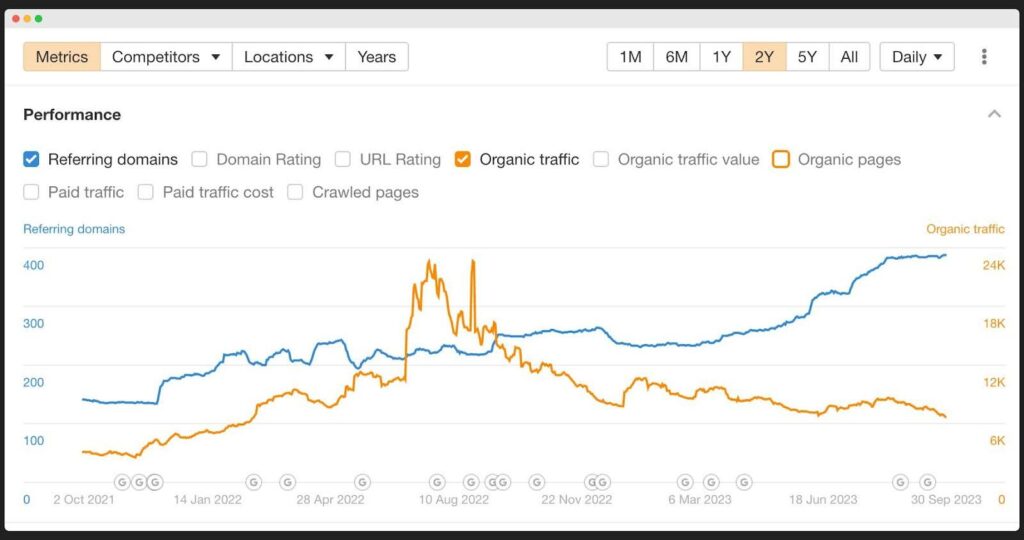
The backfire of traffic that was previously boosted with the help of black hat SEO techniques.
Black hat link building is a cheaper alternative to white hat link building, but the risks involved don’t justify the potential short-term gains.
It is worth investing time and money into white hat link building, especially compared to black or grey hat!
Think of white hat building as brand building and/or PR.
You’ll get links from major publications in your industry.
For example, I’ve taken and closed sales calls from my contributing articles in highly trusted and relevant publications. The placement in that publication paid for itself over and over again.
The thing is, white hat link building is supporting your business in more ways than just ‘link juice.’
It gets your name or your brand in front of the right audience. This will grow your brand and build trust, which will help close sales.
It’ll drive qualified traffic to your site which is hugely beneficial to all marketing channels.
White Hat Techniques That I Recommend to Use
In nearly two decades of my link-building experience, I've tried numerous techniques. Like everyone else, I prefer simple and effective methods that deliver positive results with minimal effort. The following strategies are exactly what we’re all looking for.
Editorial links
An editorial link points back to your site from a large publication and is usually gained naturally, without asking or paying for it.
So how is it a link-building technique if you can’t do anything to earn an editorial link?
Well, you can. It’s called niche edit link building.
The technique involves requesting site owners or editors to insert your link(s) in existing content.
Alternatively, you can save time and turn to an agency to gain editorial links for you.
We at Editorial.Link generate high-quality backlinks from DR 70+ sites that are relevant to the client’s niche.
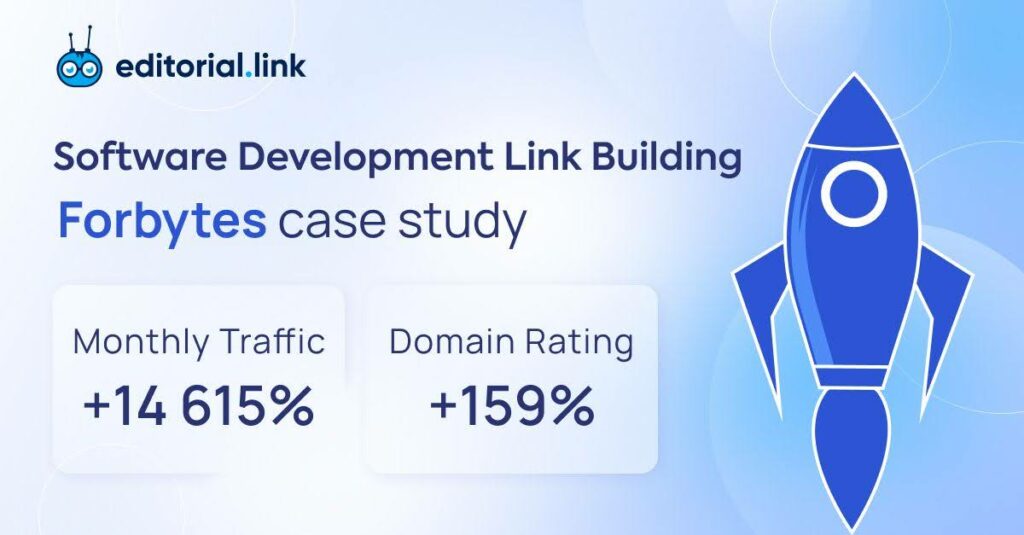
Looking to increase search traffic, Forbytes turned to Editorial.link in September 2021. In 21 months, we earned 263 backlinks from high-authority websites, including systeme.io (DR 88), blog.hubspot.com (DR 93), databox.com (DR 82), and monday.com (DR 89). The company not only boosted their link profile but also went from just 32 monthly visitors to 4677.

Connectively (formerly HARO)
HARO link building is a method of acquiring links from established publications by sharing your expertise with them.
To earn links using this method, you just need to sign up for Helpareporter and review queries daily or so. Once you’ve found the relevant request, you can pitch your answer and start monitoring the status of your submission.
I would say HARO link building, or places like Featured is a good place to start from.
These are low-budget and effective tools to get the ball rolling with a low budget.
* Featured is another resource that connects journalists and subject matter experts.
Drawbacks? A few.
First off, you may spend hours responding to requests only to discover the authors have decided to leave out your link (or even any credit at all) from your quotes.

Next, Connectively has recently introduced pricing plans, which means HARO is no longer free. Technically, there’s still a free plan — but 5 pitches/month is nothing for a link builder. The paid plan starts at $19/month for 15 pitches, with each additional pitch priced at $0.99.
At the end of the day, it’s still a worthy investment if you know how to craft pitches that get published.
Another potential issue with HARO link building is that many requests come from anonymous sources. On one hand, there might be a reputable site like Forbes hiding under that label. On the other hand, it can also be a site that’s not worth your time.
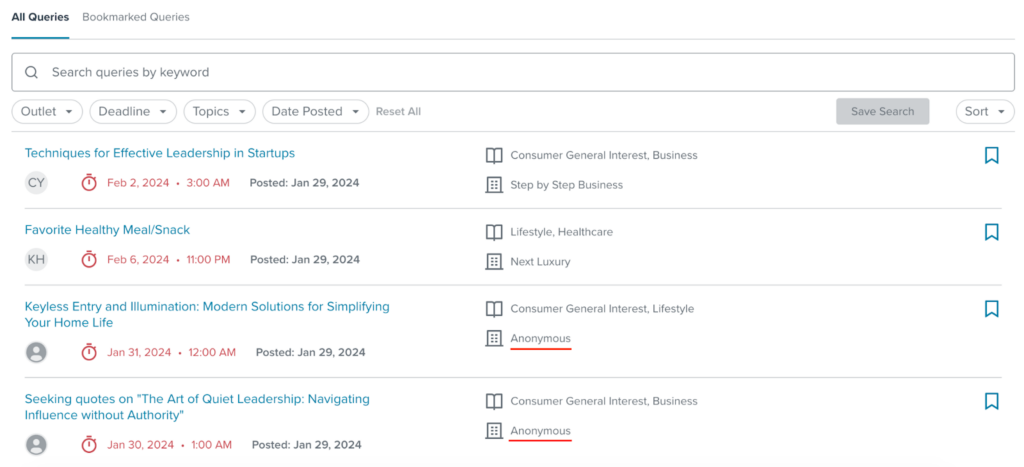
Many SEO experts recommend trying out several HARO alternatives:
My favorites currently are the classic #journorequest via X (Twitter), and also using platforms like Featured and Qwoted.
I’ve been able to see explosive growth for my own sites and my clients using this method, as you’re often obtaining backlinks from websites that you couldn’t simply buy a backlink from, and they aren’t the types of sites to quote just anyone.
So, the fact that you’re featured on a site like Forbes or Shopify goes a long way for search engines in understanding just how authoritative your site is.
And when this is done consistently, it’s easy to see how this level of trust can rapidly grow.
What differentiates the #journorequest on X from other platforms is that here, you can connect with journalists directly and have greater control over the fate of your pitches. Otherwise, all the pathways are more or less the same, and I recommend that you try them all.

Guest blogging
Guest blogging involves submitting articles to websites and news outlets relevant to your niche. Some practice it to get referral traffic, others use it for link building.
It’s a legitimate way to earn links from high-authority publications like G2, Clutch, or Outbrain, free of charge.
Alright, it’s not exactly free since you have to spend hours of work on outreach and content creation to make it work. For instance, to have your post pass the review of the G2 editorial team, it should include at least 2,500 words (and it’s just one of the many requirements). For an average writer, it’s a few days of work. A hefty investment to gain only one link.
But what if you could gain 5–10 links per publication? Guest posting immediately becomes one of the most cost-effective white hat link-building techniques.
All you need is a network of reliable link builders who, just like you, write for other sites. This way, you can secure spots for their links in your guest posts and receive a bunch of links from their content collaborations in return.
PR link building
PR link building involves using media coverage, brand mentions, and other PR activities to gain links from reputable sources.
While it’s often the only way to secure exclusive links, it also requires quite some expertise in PR. You need to understand what kind of stories attract the attention of editors and have excellent communication and copywriting skills to make your pitch stand out.
Fery Kaszoni has plenty of successful PR case studies in his briefcase. His reactive PR campaigns land around a dozen of links from the world’s best publications, including CNBC and Fox News
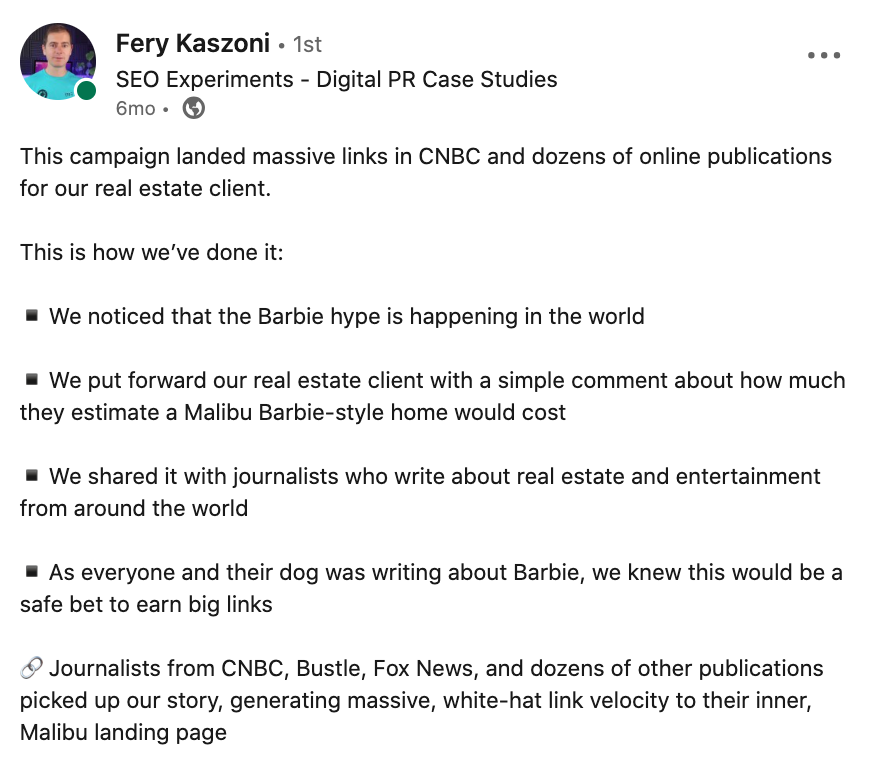
How does it work? In short, Kaszoni and his team identify a trending topic and weave a narrative around this trend, creating a storyline that resonates with the client’s niche. The results from such campaigns are impressive:

Podcast link building
Using podcasts to earn backlinks is the least conventional link-building method on this list. Yet it works.
You may question whether the effort and resources invested in preparing for and participating in podcast link building are justified for just one link. First of all, it depends. If it lands you a link from a highly reputable source, it’s probably worth it.
Secondly, you don't necessarily have to talk on a podcast to get a link. You can sponsor a podcast — just reach out to the podcast host and offer to sponsor one of their upcoming episodes in exchange for a link.
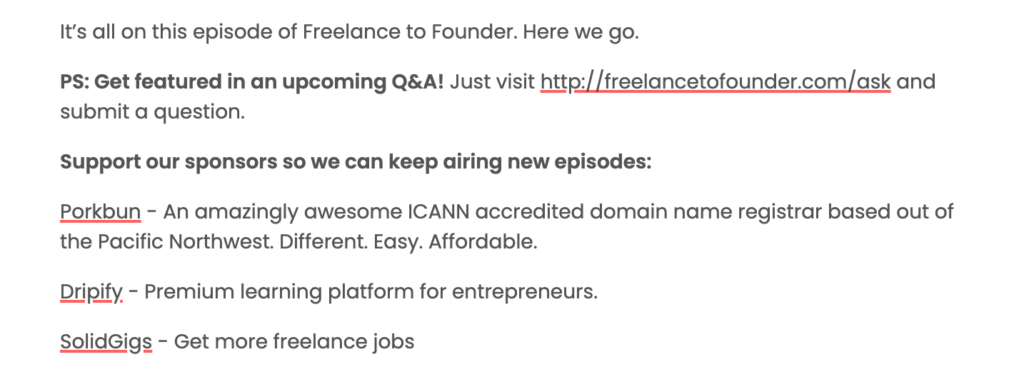
How much does it cost to sponsor a podcast?
Again, it depends. Patrick Whitener, SEO Strategist at Liquid, has recently shared the results of the experimental podcast link-building campaign with an average cost per link of $332.82. A fair price for exclusive placements.
Broken link building
This long-standing technique involves finding dead links on relevant websites and offering your own content as a replacement.
The process of finding broken links is no rocket science, and all you need is a quality backlink analysis tool. The easiest ways to go about it are:
- searching for dead pages on your competitor’s site and identifying the external sites that point out to those pages;
- searching for dead pages on a topic and identifying their referring domains.
The second one is more effective when you want to build links for specific pages. Here’s how it looks in Ahrefs:
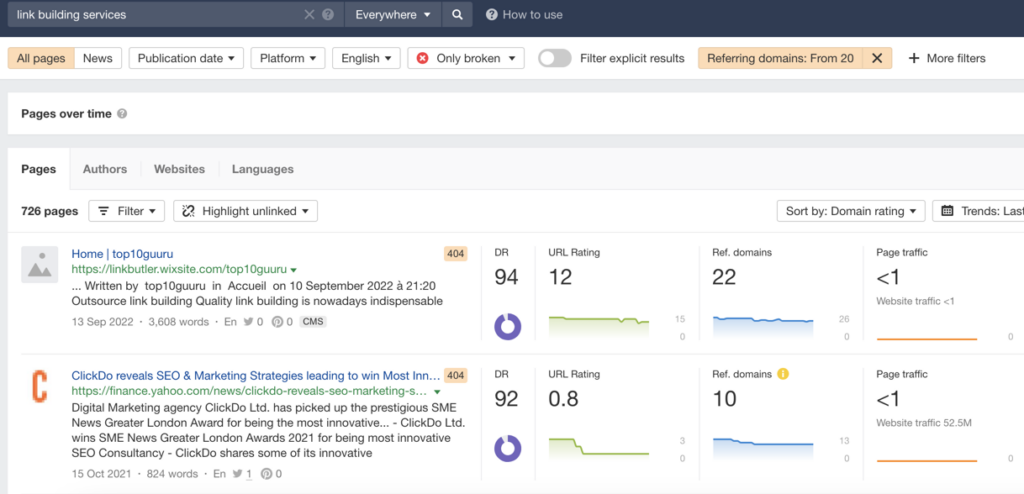
Once you’ve built up a list of relevant sites with broken links, it’s time to start outreach. And don’t forget, you can only convince a web admin to link to your content if it’s link-worthy. Speaking of which…
Link bait content
Of course, your objective is to build as many backlinks for your key commercial pages as possible. But focusing solely on your target pages will only get you so far.

Link bait content is the type of content designed to naturally attract links. To achieve this, it should provide information that people typically want to share with others.
Previously, on my Linkedin i'll share link bait cases:
"I would create link bait pages and initially build inbound links to them.
When these pages achieve high rankings in Google, they will start generating links organically.
Thanks to internal links from this 'Link Bait' page, your commercial pages will grow as well. So, you'll need fewer backlinks to promote your commercial pages."
Will link bait content help you earn links naturally if your site has 0 DA (and thus, no traffic)? No, it won’t. But it makes it much more likely that you hear “yes” when you ask a webmaster to insert your link in their content. And once your link-worthy pages pick up search rankings, they’ll generate backlinks organically at an exponential speed.
Here are the most effective types of link bait content (that haven’t worn out themselves yet):
- Statistics pages, for example our Link Building Survey 2024
- Experiments
- Infographics
- Interviews with subject matter experts (SMEs)
I would recommend publishing passive assets such as statistics pieces and data studies regularly. These studies are often cited by journalists where they’re looking for stats to quote, and you can often get links this way without having to actually do any ongoing outreach work.
Frequently Asked Questions About White Hat Link Building
What is white hat link building?
White hat link building is when you earn backlinks the right, legal way—no shortcuts, no tricks. It means creating helpful content, reaching out to trustworthy websites, and building real relationships. Everything stays within Google’s rules.
How is white hat link building different from black hat link building?
White hat is clean and ethical - you focus on quality content and natural backlinks. Black hat, on the other hand, uses shady tactics like buying links or spamming link farms, which can get you penalized by Google.
How can I ensure my link-building efforts are white hat?
Stick to the basics: create valuable content people want to link to, reach out to sites with genuine value, and avoid tricks like paid links or forum links. Always follow Google’s guidelines, and you’ll stay on the right track.
How do I measure the success of white hat link building?
Keep an eye on key metrics. Are you getting more organic traffic? Are your rankings improving? Are you earning quality links from trusted sites? These are signs that your white hat strategies are working.
How much does white hat link building cost?
If you’re creating content and doing outreach in-house, it’s more budget-friendly. But hiring experts or using tools can cost more, especially in competitive industries. The investment is worth it, though—quality beats shortcuts every time.
Want to know what white-hat link building costs? We have an article on link building pricing that lays it all out.
May the Patience Be With You
White hat link building is a long-term game. But it’s worth every minute you spend on it, given that you spend it wisely and optimize your efforts.
It’s important to not get discouraged if you don’t see results immediately, so you need to view this as a long-term investment.
‘True’ website authority can take a long time to establish, so the sooner you invest in proper white hat link building, the sooner you can start to grow your authority.
It’s all about having an unwavering view of authority growth via quality link-building methods, rather than trying to cheat the system and invest in potentially harmful link-building practices that could result in a manual penalty at a later date.
At Editorial.Link, we’ll help you see positive results from link building faster. We don’t offer thousands of placements a month, but secure high-quality, relevant links to visibly improve your site’s search performance. Let’s discuss what we could do for you based on your needs.




